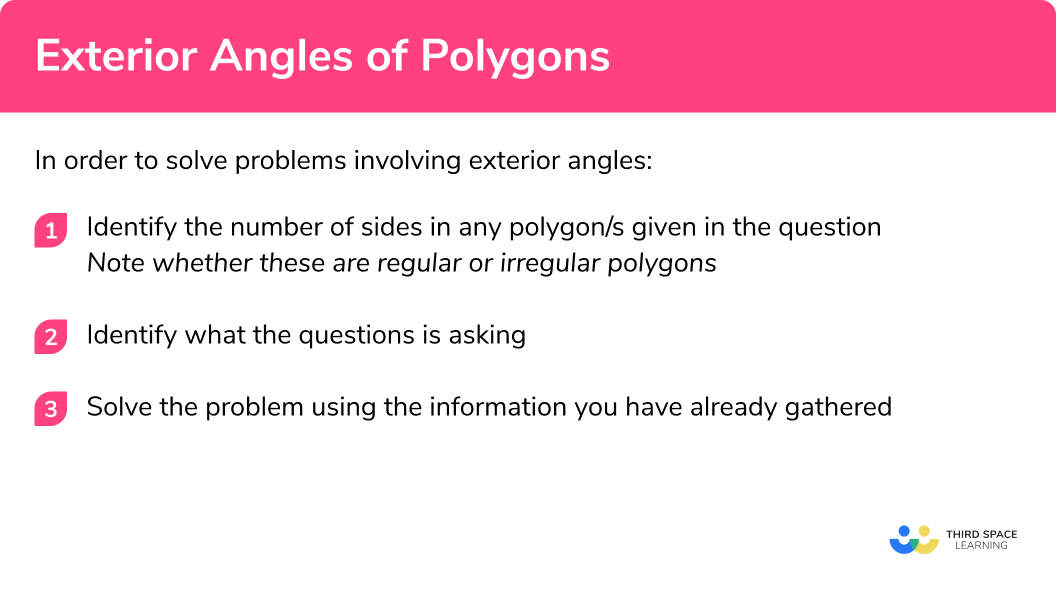GCSE Tutoring Programme
Our chosen students improved 1.19 of a grade on average - 0.45 more than those who didn't have the tutoring.
In order to access this I need to be confident with:
2D shapes Angles on a straight line Angles in a triangle Polygons Regular polygon Irregular polygonThis topic is relevant for:

Exterior Angles Of A Polygon
Here is everything you need to know about exterior angles in polygons for GCSE maths (Edexcel, AQA and OCR). You’ll learn how to calculate the sum of exterior angles for a polygon, a single exterior angle and use this knowledge to solve problems.
At the end you’ll find worksheets based on Edexcel, AQA and OCR GCSE exam style questions, along with further guidance on where to go next if you’re still stuck.
What are exterior angles?
Exterior angles are angles between a polygon and the extended line from the vertex of the polygon.
Sum of exterior angles of a polygon
Interior and exterior angles form a straight line – they add to
Check out our lessons on interior angles of polygons and sum of the interior angles to find out more.
What are exterior angles?

Keywords
- Polygon:
A polygon is a two dimensional shape with at least three sides, where the sides are all straight lines.
- Regular & irregular polygons:
A regular polygon is where all angles are equal size and all sides are equal length
E.g. a square.
An irregular polygon where all angles are not equal size and/or all sides are not equal length
E.g. a trapezium
How to solve problems involving exterior angles
In order to solve problems involving exterior angles following these steps:
- Identify the number of sides in any polygon/s given in the question.
Note whether these are regular or irregular polygons. - Identify what the question is asking recalling that the Sum of exterior angles \, \textbf{=} \; \bf{360^{\circ}}
- Solve the problem using the information you have already gathered with use of the formulae interior angle \textbf{+} exterior angle \, \textbf{=} \; \bf{180^{\circ}} and Sum of interior angles \, \textbf{=} \; \bf{(n-2) \times 180^{\circ}} if required
How to solve problems involving exterior angles.


Interior and exterior angles worksheet (includes exterior angles of a polygon)

Get your free interior and exterior angles worksheet of 20+ questions and answers. Includes reasoning and applied questions.
DOWNLOAD FREE
Interior and exterior angles worksheet (includes exterior angles of a polygon)

Get your free interior and exterior angles worksheet of 20+ questions and answers. Includes reasoning and applied questions.
DOWNLOAD FREERelated lessons on angles in polygons
Exterior angles of a polygon is part of our series of lessons to support revision on angles in polygons. You may find it helpful to start with the main angles in polygons lesson for a summary of what to expect, or use the step by step guides below for further detail on individual topics. Other lessons in this series include:
Exterior angles of polygons examples
Example 1: finding the size of a single exterior angle for a regular polygon
Calculate the size of a single exterior angle for a regular hexagon.
- Identify the number of sides in any polygon/s given in the question. Note whether these are regular or irregular shapes.
A hexagon has 6 sides.
Regular – therefore all exterior angles are equal.
2Identify what the question is asking recalling that the Sum of exterior angles \, \textbf{=} \; \bf{360^{\circ}}
The size of one exterior angle.
We know the sum of exterior angles for a polygon is
3Solve the problem using the information you have already gathered with use of the formulae interior angle \textbf{+} exterior angle \, \textbf{=} \; \bf{180^{\circ}} and Sum of interior angles \, \textbf{=} \; \bf{(n-2) \times 180^{\circ}} if required
The size of each exterior angle is
Example 2: finding an exterior angle given an interior angle for an irregular polygon
An irregular octagon has one interior angle of size
Identify the number of sides in any polygon/s given in the question. Note whether these are regular or irregular polygons.
Identify what the question is asking recalling that the Sum of exterior angles \, \textbf{=} \; \bf{360^{\circ}}
As adjacent means next to we are being asked to find the size of the exterior angle which is on an straight line with the interior angle.
Solve the problem using the information you have already gathered with use of the formulae interior angle \textbf{+} exterior angle \, \textbf{=} \; \bf{180^{\circ}} and Sum of interior angles \, \textbf{=} \; \bf{(n-2) \times 180^{\circ}} if required
We know that angles on a straight line add to
Example 3: interior + exterior angle = 180º
Calculate angle
Identify the number of sides in any polygon/s given in the question. Note whether these are regular or irregular polygons.
The interior angles of a hexagon add to 720 degrees.
Identify what the question is asking recalling that the Sum of exterior angles \, \textbf{=} \; \bf{360^{\circ}}
Find the exterior angle
It is an irregular polygon so the exterior angles are not all equal.
Solve the problem using the information you have already gathered with use of the formulae interior angle \textbf{+} exterior angle \, \textbf{=} \; \bf{180^{\circ}} and Sum of interior angles \, \textbf{=} \; \bf{(n-2) \times 180^{\circ}} if required
We can work out the missing interior angle of the polygon.
The interior angle + the exterior angle must equal
Therefore
So
Example 4: finding the number of sides given the exterior angle of a regular polygon
An exterior angle of a regular polygon is
Identify the number of sides in any polygon/s given in the question. Note whether these are regular or irregular polygons.
Unknown number of sides.
Regular polygon – therefore all exterior angles are equal.
Identify what the question is asking recalling that the Sum of exterior angles \, \textbf{=} \; \bf{360^{\circ}}
We need to find the number of sides.
We know the sum of the exterior angles is
Solve the problem using the information you have already gathered with use of the formulae interior angle \textbf{+} exterior angle \, \textbf{=} \; \bf{180^{\circ}} and Sum of interior angles \, \textbf{=} \; \bf{(n-2) \times 180^{\circ}} if required
Therefore the polygon has
Example 5: finding the number of sides given the interior angle of a regular polygon
The size of each interior angle of a regular polygon is
Identify the number of sides in any polygon/s given in the question. Note whether these are regular or irregular polygons.
Unknown number of sides.
Regular polygon – therefore all exterior angles are equal.
Identify what the question is asking recalling that the Sum of exterior angles \, \textbf{=} \; \bf{360^{\circ}}
We need to find the number of sides.
We know the sum of the exterior angles is
We also know that the sum of an interior and an exterior angle is
Solve the problem using the information you have already gathered with use of the formulae interior angle \textbf{+} exterior angle \, \textbf{=} \; \bf{180^{\circ}} and Sum of interior angles \, \textbf{=} \; \bf{(n-2) \times 180^{\circ}} if required
If the interior angle is
The number of sides can therefore be calculated by
The polygon has
Example 6: multi step problem involving interior and exterior angles
The size of each interior angle of a regular polygon is
Identify the number of sides in any polygon/s given in the question. Note whether these are regular or irregular polygons.
Unknown sides.
Regular polygon – therefore each exterior angle is equal.
Identify what the question is asking recalling that the Sum of exterior angles \, \textbf{=} \; \bf{360^{\circ}}
Number of sides of the polygon.
Other Information we know:
Total of Exterior Angles
Interior
Solve the problem using the information you have already gathered with use of the formulae interior angle \textbf{+} exterior angle \, \textbf{=} \; \bf{180^{\circ}} and Sum of interior angles \, \textbf{=} \; \bf{(n-2) \times 180^{\circ}} if required
We will call each of the interior angles
Since
Therefore
The size of one exterior angle is
The number of sides of the polygon is
The Polygon has
Common misconceptions
- Misidentifying the exterior angle
E.g.
The exterior angle of a triangle is the angle between the side and the extension of an adjacent side.
Here the interior angle (internal angle) is
- Miscounting the number of sides
- Misidentifying if a polygon is regular or irregular
- Incorrectly assuming all the angles are the same size
- Misidentifying which angle the question is asking you to calculate
Practice exterior angles of a polygon questions
1. Find the size of one exterior angle for a regular quadrilateral.




Exterior angles of a polygon add up to 360 . A regular quadrilateral has 4 interior angles equal in size, so the four exterior angles are equal.
This means we can divide 360 by 4 to get the solution.
2. Find the size of one exterior angle for a regular octagon.




Exterior angles of a polygon add up to 360 . A regular octagon has 8 interior angles equal in size, so the eight exterior angles are equal.
This means we can divide 360 by 8 to get the solution.
3. Find the size of one exterior angle for a regular nonagon.




Exterior angles of a polygon add up to 360 . A regular nonagon has 9 interior angles equal in size, so the nine exterior angles are equal.
This means we can divide 360 by 9 to get the solution.
4. Each of the exterior angles of a regular polygon is 12^{\circ} .
How many sides does the polygon have?
12 sides

20 sides

30 sides

32 sides

Exterior angles of a polygon add up to 360 .
This means we can divide 360 by 12 to get the solution.
5. Each of the exterior angles of a regular polygon is 20^{\circ} .
How many sides does the polygon have?
12 sides

20 sides

18 sides

16 sides

Exterior angles of a polygon add up to 360 .
This means we can divide 360 by 20 to get the solution.
6. Four interior angles in a pentagon are 125^{\circ} each.
Find the size of the other angle
125^{\circ}

40^{\circ}

55^{\circ}

140^{\circ}

The four known exterior angles will be 55^{\circ} , since angles on a straight line sum to 180 . This means the fifth exterior angle will be 140^{\circ} because exterior angles add up to 360 .
Using angles on a straight line once more means that the missing angle is 40^{\circ} .
Exterior angles of a polygon GCSE questions
1. A regular polygon has 15 sides. Calculate the size of one exterior angle.
(1 mark)
360 ÷ 15 = 24
= 24^{\circ}
(1)
2. (a) The diagram below shows part of a regular polygon. Calculate the size of the exterior angle of the polygon.
(b) Work out how many sides this polygon has.
(3 marks)
(a)
180 – 162=18
= 18^{\circ}
(1)
(b)
360 ÷ 18
(1)
20
(1)
3. Shown below are parts of two regular polygons.
Polygon A has 9 sides and an exterior angle of x.
Polygon B has an interior angle of 3x.
How many sides does polygon B have?
(4 marks)
360 ÷ 9 = 40
(1)
x = 40, 3x = 120
(1)
Polygon B: Interior angle is 120^{\circ} , exterior angle is 60^{\circ}
(1)
360 \div 60 = 6
(1)
Learning checklist
You have now learned how to:
-
Use conventional terms for geometry e.g. exterior angle
-
Derive a formula for the total of exterior angles for a polygon and consequently calculate the sum of exterior angles for a regular polygon
-
Solve problems involving interior and exterior angles
The next lessons are
Still stuck?
Prepare your KS4 students for maths GCSEs success with Third Space Learning. Weekly online one to one GCSE maths revision lessons delivered by expert maths tutors.

Find out more about our GCSE maths tuition programme.